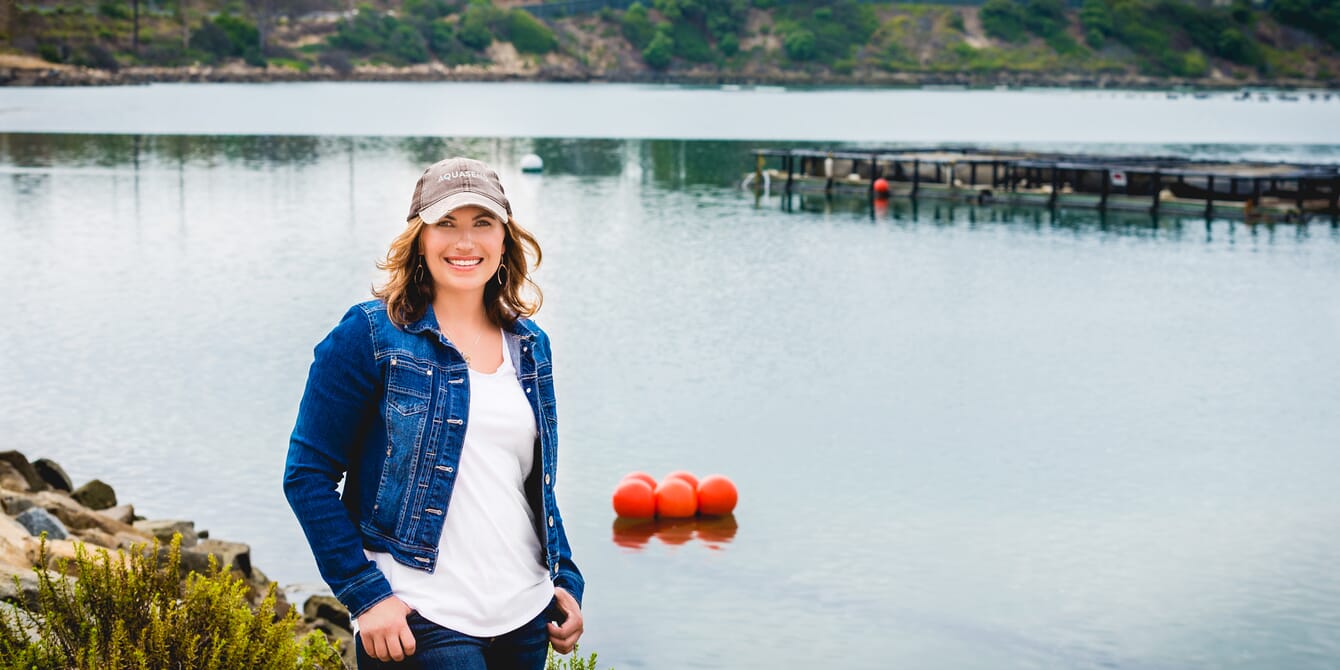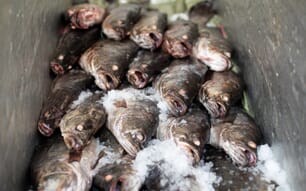
© Aquasend
What are Aquasend’s products and what makes them unique?
Aquasend provides technology and software that allows farmers to view real-time measurements of dissolved oxygen and temperature from their phone, tablet or computer. The flagship product, called the Beacon, provides continuous monitoring of dissolved oxygen, via an optical sensor, and temperature. It’s a solar powered, cloud-based buoy that provides weeks of sensor stability before maintenance is required. The buoy is roughly 15 inches in diameter and weighs approximately 12 pounds.
With decades of sensor development experience, we overcome a large barrier to entry, which is creating a high quality, long lasting and stable sensor that maintains performance over time in the harsh demands of aquaculture waters. Our unique patent pending anti-fouling combination produces weeks of sensor stability before maintenance is required. With a low power sensor, the buoy can operate on a small solar panel and telemeter data every 10 minutes to a cloud-based operating system. Alarms prevent harvest loss due to critical oxygen levels and our customers can view their Beacon data from any location in the world.
We also provide the aquaculture community with the miniDOT Logger, a device which logs optical oxygen internally and stores all data on an SD card. The loggers are suitable for fish transportation and applications that can benefit from continuous sampling of oxygen and temperature, but do not require the need for real-time monitoring.
How widely have they been adopted by the aquaculture sector?
Our beacons are being used by farms supporting species such as catfish, tilapia, shrimp, trout, barramundi, oysters and carp in the USA, Italy, Mexico and Australia.
We have thousands of sensors all over the world sampling data from some of the most remote and challenging waters on this planet.
Can you tell me a bit about your background?
My parents, Michael and Sandra Head, founded the environmental sensor monitoring company, Precision Measurement Engineering (PME), when I was born. At this time, we provided researchers around the world with micro-scale water quality sensors that allowed our customers to collect data on fluid dynamics, mixing events, and micro data monitoring of water column events.
After receiving my bachelor of arts in communications and sociology, from University of California, San Diego, I decided to pursue a career in marketing and public relations. After working for various agencies (almost considering the job of a news anchor), I decided to work part-time for the family business and see how my skills could contribute. I helped with a variety of tasks: from redesigning their website, to manufacturing some of the sensors. I have worked in all departments of the company, and it gave me a broader perspective of the business and innovation.
I wanted to explore all other facets of business, so I obtained my master of business administration from California State University San Marcos. This began to light a passion to grow the company and recognise our core competencies for innovating valuable solutions for a variety of customers and industries.
What inspired you to work with the aquaculture sector?
After attending our first Aquaculture America show in 2017, we realised there was a lack of innovation for continuous water quality monitoring solutions. Our curiosity led us to conversations with the director of aquaculture in Washington DC, the president of the World Aquaculture Society, the USDA, NOAA, and numerous farmers from all over the country. We toured processing plants, learned about nutrition and feed, spent hours on catfish, tilapia, trout, barramundi and shrimp farms. It was our mission to learn as much as possible about farming practices and problems that this industry faces.
We learned how dissolved oxygen is critical for maintaining healthy waters, improving harvest growth, and ensuring overall nutrition performance. Dissolved oxygen is important for aquatic life and is necessary for overall ecosystem balance. Our excitement to provide solutions propelled R&D and opened new ideas for sensor connectivity, data communication, software, anti-fouling modifications and technology.

Beacons are solar powered sensors that provide continuous monitoring of levels of dissolved oxygen in the water, as well as water temperature. © Aquasend
What’s your role in the company and what does a typical day consist of for you?
As the CEO my role is to define the strategic vision and direction for the company. Over the past decade I have built a passionate team of 18 employees, launched our Aquasend brand, supported the business not only through a recession, but also a pandemic, built our global distribution sales network and successfully completed our last accelerator through Xylem, Inc.
A typical day for me starts with conversations around the business to check in on the team, meet with other companies in the water space to discuss potential product collaborations, trending applications and the possibility of working synergistically to support the water monitoring industries. I’m also engaged with the Aquasend team reviewing our current pilots, evaluating metrics to ensure R&D progression, and ensuring that the team is successful in all that they do. I find a joy in learning about individual farms and how our products can help them to better manage their water quality.
What have been Aquasend’s major milestones to date?
Conceptual design and initial first phases of the Beacon product began in 2017. We worked closely with tilapia farms in California and catfish farms in Mississippi focused on understanding fouling and how the warmer waters at these farms easily overtook an optical oxygen sensor.
The next few years saw some of our first pilots in a Kauai shrimp farm, tilapia farms in California, catfish farms in Mississippi and Alabama, and an oyster farm in Maryland. We officially launched the product at the Aquaculture America show in Honolulu the spring of 2020.
In 2021 we released our third revision of the Aquasend Beacon and piloted in a tilapia farm in Arizona, as well as initiated progress towards international telemetry. In 2022 the company was accepted into the Xylem Innovation Lab’s Accelerator and successfully installed Beacons in semi-intensive shrimp farms in Mexico, an ancient Hawaiian Fishpond on Oahu, and a trout farm in California. We found great success with our patent pending anti-fouling combination that allows our sensors to be stable and provide accurate data for weeks, sometimes months, before maintenance is required to clean the sensor.
In 2023 we officially became a part of the Hatch portfolio and prepared to launch at their accelerator in 2024. This year we successfully installed Beacons in an aquaculture farm in Australia.
What challenges do you still need to overcome?
Our biggest challenge is finding partners to help us scale for international launch. A typical farm in the US could easily need 50 units and a typical international farm can easily demand hundreds of units. It’s necessary to instrument the majority of the ponds at a farm as our solution increases growth rates, reduces electricity costs and minimises labour.

© Aquasend
What do you hope to achieve in Hatch Blue's Crest accelerator programme?
A successful accelerator will allow us to define our strategic vision, prepare the company for fundraising, and introduce us to the demands and problems of international farms. We have learned a lot more about farming practices in Norway, Singapore and Vietnam by visiting farms in these companies, which we can use as a launching step towards global supply.
How would you like the company to evolve in the coming decade?
The next decade will bring us opportunities to provide the aquaculture sector with a variety of technologies and software to effectively manage their farms. We have a product roadmap to position Aquasend as one of the leading aquaculture water quality monitoring brands globally. We are pursuing key partnerships to enhance our products and allow for greater water quality analysis of a variety of key parameters. Our passion for data will allow us to achieve new levels of software development that allow our customers to understand how shifts in farm practices can help prevent harvest loss through the use of forecasting, trend analysis and eventually AI.
How do you think your technology can help the evolution of the aquaculture sector?
Water quality is the foundation of health and success at any farm. Our mission is to remove the frustration of monitoring water quality and bring simple, yet powerful solutions to this industry. By removing the need to constantly maintain sensors and equipment, we can allow our customers to focus on other key activities such as optimising farm operations, improving growth rates and securing healthy harvests. Aquasend is bringing IoT sensors and data connectivity to the fingertips of farmers around the world, allowing them to access key data instantaneously from any point in time.

© Aquasend








